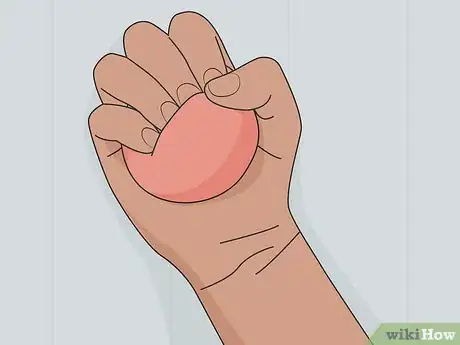This article was co-authored by Trudi Griffin, LPC, MS. Trudi Griffin is a Licensed Professional Counselor in Wisconsin specializing in Addictions and Mental Health. She provides therapy to people who struggle with addictions, mental health, and trauma in community health settings and private practice. She received her MS in Clinical Mental Health Counseling from Marquette University in 2011.
There are 20 references cited in this article, which can be found at the bottom of the page.
This article has been viewed 1,464,360 times.
Anger is a natural human emotion, and it’s not always negative. It can help you know when you’ve been hurt or when a situation needs to change. It's important to learn how to process and react to your anger. Frequent feelings of anger have been linked to higher risk of heart disease, high blood pressure, depression and difficulty sleeping. This is especially possible if you experience highly explosive anger or your anger is extremely repressed.[1] Fortunately, you can learn to understand, process, and release your anger in healthy ways.
Steps
Releasing Your Anger Productively
-
1Get some exercise. When you’re feeling angry, doing some moderate exercise could help you. A study by the University of Georgia suggests that moderate exercise (such as running or riding a bike) during or immediately after an upsetting experience can help you manage the experience of anger. When you exercise, your body releases endorphins, which are natural "feel-good" chemicals that make you feel more positive and happy.[2] If you're unable to run or ride a bike, consider walking, stretching, and other easier forms of exercise.[3]
- Exercise may also have a preventive effect. A Yale study suggested that prolonged bouts of running before an upsetting experience may dampen the extremity of your emotional reaction.[4]
- Even if you can't take time for a full exercise routine when you're angry, try take a few moments. Leave the situation that's making you angry if you can, and shake out your limbs vigorously. Even small physical distractions can help you feel better.[5]
-
2Practice controlled breathing. Breathing deeply from your diaphragm (the large muscle at the base of your lungs that assists with breathing) can help soothe feelings of anger.[6] Deep, controlled breathing slows your heartbeat, stabilizes blood pressure, and relaxes your body.[7] Combine your breathing exercise with a mantra, or calming word or phrase, for added benefit.
- Find a quiet place to relax. Make yourself comfortable. Lie down if you like, and loosen any tight or uncomfortable clothing.
- Place your hand on your abdomen.
- Inhale slowly through your nose. Focus on filling your belly with air as you breathe in. Let your abdomen relax as you inhale; you should be able to feel your stomach expand. Hold this breath for a few seconds.
- Breathe out slowly through your mouth. Contract your abdominal muscles to push all the air out of your lungs.
- Repeat this process at least ten times.
- If you're still having trouble with deep breathing, buy a bottle of children's bubbles from the toy store. Hold the bubble wand in front of your face and breathe slowly through the wand. Focus on exhaling from your lower abdomen, squeezing your breath up and out. Steady, even breathing will produce a flow of bubbles. If your bubbles break or don't appear, alter your breathing until they do.[8]
Advertisement -
3Practice progressive muscle relaxation. Progressive muscle relaxation requires you to focus on tensing and relaxing particular muscle groups in your body, so it can help distract you from your feelings of anger. Additionally, it is excellent for relieving anxiety and tension, which can also help alleviate angry feelings. This exercise also works to help you sleep when your thoughts are out of control.[9]
- Go to a quiet, comfortable place if possible, and find a seat.
- Focus on a particular muscle group, such as the muscles in one hand. While inhaling deeply and slowly, squeeze the muscles in that group as hard as you possibly can and maintain that tension for 5 seconds. For example, tensing your hand muscles would involve forming a tight fist. Focus on that group of muscles and try not to accidentally tense surrounding muscles.
- Exhale and quickly release the tension in the muscle group you just tensed. Focus on the experience of the tension leaving those muscles. Allow yourself to relax for about 15 seconds, then move on to another muscle group.
- Other muscle groups to try tensing and relaxing are the foot, lower leg, thigh, buttocks, stomach, chest, neck and shoulders, mouth, eyes, and forehead.
- You can also start at your feet and work your way up your body, tensing each group of muscles. As you release each muscle group, imagine the anger leaving your body as you feel the relaxation take over.
-
4Perform an anger release ceremony. Focused activities may help channel your angry energy into a productive expression so that you can move past your immediate feelings of anger. Research has shown that anger can even temporarily enhance brainstorming and creative thinking.[10] Engage your imagination and mindfully release your anger in a controlled, creative way.[11]
- For example, find a private place to shake your body and imagine that you are literally shaking off your anger just like a dog shakes off water after a bath.
- Another example could be writing down angry thoughts on a piece of paper and then slowly tearing the paper apart, imagining that you are also destroying your feelings of anger.
- If you're artistic, try sketching or painting something that expresses how you feel. Focus on moving your feelings out of yourself and into the artwork. You could also write a poem about how upset you are.
-
5Use a stress-relief toy. A stress-relief toy, such as a stress ball, can help in the immediate experience of anger. Because they prompt you to squeeze and release a group of muscles, stress balls can give you some of the benefits of progressive muscle relaxation more immediately. However, they are a stop-gap solution and should be coupled with other techniques for the best long-term results.[12]
- It's much better to use a stress-relief toy than it is to release anger by punching, kicking, or throwing things. Explosive actions like these can cause harm or damage, and they often increase your anger rather than help it.
-
6Find something funny or silly. Silly humor can actually help defuse your anger. A significant root cause of a lot of anger is the feeling that our own ideas about a situation or experience are always right and that things ought to go in the way we expect them to. Using humor to approach and deconstruct these ideas can help calm you down and manage your anger.[13]
- For example, the American Psychological Association recommends that, if you find yourself calling someone a derogatory name, you imagine it literally. So, if you’re so angry at your boss that you call him a “douchebag,” imagine what it would look like if your boss literally were a douchebag, complete with suit and briefcase. This type of humor may help you feel less tense.
- Looking at silly or cute videos online can also help you lighten your mood. Humans are biologically programmed to find things such as large-eyed puppies and tiny fat babies adorable, and we have a chemical reaction of happiness to seeing these things.[14]
- Avoid sarcastic or cruel humor, as this type of humor is likely to just make your anger worse and can also hurt others.
-
7Listen to calming music. Listening to music can be an excellent distraction technique that can help you release your anger. However, it’s important that you listen to calming music. When you’re already feeling angry, music with aggressive beats or angry lyrics may actually make your negative feelings more intense.[15]
- Find quiet, tranquilizing music to help soothe your anger. Part of what makes you feel so "revved up" when you're angry is that your body has entered a "fight or flight" state of excitement.[16] The British Academy of Sound Therapy has created a playlist of songs deemed "relaxing" by scientific study, including songs by Marconi Union ("Weightless"), Airstream ("Electra") and Enya ("Watermark").
-
8Repeat self-calming statements. Find a statement that is meaningful to you, and try focusing your attention on this statement as you repeat it. You can even repeat a few statements to yourself. Here are a few you could try:
- “This situation is only temporary.”
- “I can make it through this.”
- “I might not like it, but it’s not going to kill me.”
- “I will keep my cool about this.”
- “This isn’t worth getting upset about.”
Controlling and Preventing Anger
-
1Develop an “anger plan.” Because it can be very hard to come up with ways to reduce your anger in the heat of the moment. Try coming up with an advance plan to help you calm yourself in the event that you get angry. Having this plan in mind will help you manage your anger productively.
- For example, you might plan to take a “time out” if you feel yourself beginning to grow angry, in which you calmly tell the other person that you’re feeling upset and need to take a break.
- If you are in a conversation that’s making you angry -- such as a conversation about a heated issue like politics or religion -- make an effort to shift the conversation to a more neutral and pleasant topic.
-
2Restructure your thinking. Cognitive restructuring can help you experience anger less frequently. Anger often leads to exaggerating your response to events or experiences and can make you spiral out of control. Changing the way you think about your experiences and goals can help you both avoid feeling angry in the first place and manage your anger when you do experience it.[17]
- Avoid totalizing words like “never” or “always.” One tendency of anger is that it blots out our memory of other experiences, which can increase frustration. These words also hurt others and make people feel defensive instead of cooperative. Instead of saying things such as “I’m always such an idiot” or “You never remember what’s important,” focus on what is actually occurring. You may find it helpful to make a plain statement of fact to yourself, such as “I forgot my cellphone at the house” or “You forgot our dinner plans,” to help you keep things in perspective.
- Remain logical. Of course it’s easier said than done, but reminding yourself that the negative experience encouraging you to feel angry isn’t the only experience you will likely have that day. Remembering that the irritation, no matter how big it may seem, is only temporary will help you overcome your feelings of anger more quickly.
-
3Approach situations with flexibility. It’s easy to assume that your first impression of a situation or experience is the “right” one, and it can be very difficult to give up the idea that there is an objective truth to every situation. However, being more flexible with how you approach experiences and events will help you react with less anger to them.
- For example, if someone cut in front of you while you were waiting in line at the store, you might assume they don’t care about your needs and were being rude, and that assumption could lead you to feeling angry. While that assumption might be true, it’s not productive. Approaching that experience flexibly, such as imagining that the other person just didn’t see you or may be preoccupied with some stressful issue of their own, will help you let go of the personal feeling of anger.
-
4Learn assertiveness. Developing an assertive communication style can help you feel more in control of your own life and experience less anxiety and anger. Assertive communication and behavior isn’t about being arrogant or selfish; it’s just about clearly and calmly expressing your thoughts, feelings, and needs to others in an open and honest way. If you aren’t honest with others about your needs, they may not be able to meet them, and that experience can result in your feeling angry, depressed, and unvalued.[18]
- Use “I”-focused statements such as “I’m feeling confused about what you said” or “I would like you to be on time when we go to see a movie together.”
- Avoid name-calling, threats, and attacks on the other person.
- Use cooperative statements and invite others’ opinions.
- Be as direct and clear as possible about your desires and needs. For example, if you’ve been invited to a party that you don’t want to attend, don’t just say something like “Oh, well,I guess I’ll go if I have to.” Instead, state clearly but politely that you don’t want to go: “I would prefer not to attend that party.”
-
5Try meditating. Meditation not only decreases anxiety and alleviates depression, it also can help you maintain your calm even during upsetting experiences. A recent Harvard study showed that meditation has a positive effect on your brain function, especially in the area of emotional processing.[19] The study examined two forms of meditation: “mindfulness” meditation and “compassionate” meditation. While both reduced participants’ feelings of anxiety and anger, compassionate meditation was even more effective than just mindfulness.
- Mindfulness meditation focuses on being completely present in the moment and being aware of and accepting your body’s experiences. This type of meditation is similar to the meditation you might do in a yoga class.
- Compassionate meditation, also sometimes called loving-kindness meditation, is based on a set of lo-jong, or Tibetan Buddhist practices, focused on developing your feelings of compassion and love for others.[20] This type of meditation may require you to seek some instruction before you can effectively practice it on your own.
-
6Get enough sleep. Sleep deprivation can do a variety of damages to your body, including causing physical stress and increasing your risk of developing a mood disorder such as depression or anxiety. Poor sleep or too little sleep can also cause irritability, mood swings, and a tendency to feel angry more often than usual.[21]
- Sleep experts recommend that the average adult get an average of at least seven to eight hours of sleep per night, although you may require more or slightly less sleep to feel fully satisfied depending on your own body’s needs.
-
7Share your experiences with the person who angered you. Once you have let go of your angry feelings, sharing your feelings and experiences with the person who angered you can be helpful. For example, if someone hurt your feelings by ignoring you at a party, calmly talking to that person and explaining why you felt hurt may help them understand how their behavior affected you. It may also help you feel more in control of the situation.
- It is very important to wait until you’ve processed your anger to talk with the other person. If you approach them while you’re angry, you will likely only make the situation worse, and you could end up causing hurt as well. Always use non-violent communication when interacting with others.
-
8See a therapist. A therapist can help you work through the underlying feelings and motivations behind your anger. This is especially helpful if your feelings and their causes aren’t particularly clear to you. Cognitive therapy, in which therapists help you learn how to think about experiences differently, can be particularly helpful for anger management.[22]
Understanding Your Anger
-
1Recognize problematic anger. Most people experience mild anger a few times every week. In some cases, it’s perfectly normal to feel angry, such as if you feel someone has insulted or hurt you. However, you should learn to recognize signs that your anger has verged into the “problem” category.[23]
- Do you frequently yell, scream, or curse when you’re angry? Do you verbally lash out at others?
- Does your anger frequently lead to physical aggression? How severe is the expression of this aggression? Less than 10 percent of normal anger episodes involve physical aggression, so if you’re experiencing it often, that could be a sign that something more serious is at issue.
- Do you feel the need to self-medicate when you’re angry, such as by using drugs, alcohol, or food?
- Do you feel that your anger negatively affects your personal relationships, your job, or your general health? Have others expressed these concerns to you?
-
2Learn to read your body. Anger can cause a variety of physical symptoms, particularly in women, who are often taught by social and cultural pressures to avoid expressing hostility and anger openly.[24] Feelings of physical tension or muscle aches, rapid breathing, feeling jittery, and experiencing headaches are all symptoms that can be linked to anger. Understanding when you’re really feeling angry, rather than trying to repress that knowledge, can help you process your anger.
- Anxiety, depression, and insomnia can also be linked to feelings of anger.
-
3Examine the anger patterns in your family history. The ways in which your parents and other family members expressed their anger have a significant effect on your own patterns of dealing with it. How did members of your family process and express their anger when you were growing up? Did your parents openly express anger, or was it repressed?[25]
-
4Keep an anger journal. One way to become more in touch with your feelings and why you’re experiencing anger is to write down your emotions in detail. Reflect on not only what happened during an event or experience, but how you reacted and what your train of thought was. Try not to judge these feelings as you write. Just express them so that you can become aware of what you’re feeling. Awareness is a crucial first step to processing and overcoming anger. Ask yourself the following questions for each entry:
- What incited your feelings of anger or stress? Were you already feeling stressed before this incident?
- What thoughts did you experience during this experience?
- On a scale of 0-100, how angry do you think you felt?
- Did you lash out at others or internalize your anger?
- Did you notice any physical symptoms, such as an elevated heart rate or headache?
- What responses did you want to have? Did you want to scream, attack someone, or smash things? What responses did you actually have?
- How did you feel after the incident or experience?
-
5Learn your triggers. Anger in particular is easily triggered in many people by specific thoughts or incidents. You can use your anger journal to determine patterns in what seems to set off your anger response most often. Trigger thoughts fall broadly into two main categories: feeling that you’re in danger of being harmed, and feeling that you’ve actually been harmed in some way.
- A very common trigger thought is that someone has done or not done something you expect them to. For example, if you arranged to meet a friend for dinner and they didn’t show up, you might feel angry that they didn’t do what you’d expected them to.
- Another common trigger thought is feeling like something is causing you harm, even in a very general way. For example, being cut off in traffic, having computer issues, and constantly dropping calls on your cellphone happen frequently, but these incidents can carry real, negative consequences that create a worry of experiencing harm. That worry can trigger anger.
- Feeling as though you haven’t achieved a personal goal or need can also trigger anger, in this case anger directed at yourself.
- Feeling as though you’re being taken advantage of or that people don’t help or care about you are also common triggers, especially at work and in romantic relationships.
Warnings
- If you find yourself frequently lashing out at others or yourself when angry, or if you frequently self-medicate your anger with drugs or alcohol, seek professional mental health help. It’s important to get help so that you don’t harm yourself or others.⧼thumbs_response⧽
- Do not do physically aggressive actions like kicking, punching, or smashing things to release anger. These actions may seem as though they help, but research shows that they actually increase your feelings of anger.⧼thumbs_response⧽
References
- ↑ http://www.webmd.com/balance/stress-management/features/how-anger-hurts-your-heart
- ↑ http://www.webmd.com/depression/guide/exercise-depression
- ↑ http://www.ncbi.nlm.nih.gov/pubmed/20479481
- ↑ http://www.ncbi.nlm.nih.gov/pubmed/20479481
- ↑ https://www.psychologytoday.com/blog/mindful-anger/201405/the-five-steps-mindfully-releasing-anger
- ↑ http://www.apa.org/helpcenter/controlling-anger.aspx
- ↑ http://www.health.harvard.edu/mind-and-mood/relaxation-techniques-breath-control-helps-quell-errant-stress-response
- ↑ http://www.webmd.com/balance/guide/all-stressed-out?page=2#2
- ↑ http://www.anxietybc.com/sites/default/files/MuscleRelaxation.pdf
- ↑ http://www.scientificamerican.com/article/anger-gives-you-a-creative-boost/
- ↑ https://www.psychologytoday.com/blog/mindful-anger/201405/the-five-steps-mindfully-releasing-anger
- ↑ http://www.huffingtonpost.com/2013/04/09/stress-relief-tools-old-fashioned-remedies_n_3022241.html
- ↑ http://www.apa.org/topics/anger/control.aspx
- ↑ http://www.scientificamerican.com/article/cuteness-inspires-aggression/
- ↑ http://www.apa.org/helpcenter/recognize-anger.aspx
- ↑ https://www.psychologytoday.com/blog/evolution-the-self/201208/powerful-two-step-process-get-rid-unwanted-anger
- ↑ http://www.apa.org/helpcenter/controlling-anger.aspx
- ↑ http://www.cci.health.wa.gov.au/docs/Assertmodule%202.pdf
- ↑ http://news.harvard.edu/gazette/story/2012/11/meditations-positive-residual-effects/
- ↑ http://www.ncbi.nlm.nih.gov/pmc/articles/PMC3485650/
- ↑ http://healthysleep.med.harvard.edu/need-sleep/whats-in-it-for-you/mood
- ↑ http://www.apa.org/monitor/mar03/advances.aspx
- ↑ http://www.apa.org/monitor/mar03/advances.aspx
- ↑ http://www.prevention.com/mind-body/emotional-health/healthiest-ways-express-anger
- ↑ http://www.prevention.com/mind-body/emotional-health/healthiest-ways-express-anger
About This Article
To release anger productively, do some moderate exercise, like running or biking, to release your body’s natural “feel good” chemicals. Deep, controlled breathing can also help release anger, so find a quiet place, put your hand on your belly, inhale slowly into your hand, and then relax as you exhale. Repeat this process at least 10 times as you calm down. You can also try repeating a calming statement that’s meaningful to you, like “I can survive this,” or “This is only temporary.” To learn how to keep an anger journal, keep reading!



















































































Medical Disclaimer
The content of this article is not intended to be a substitute for professional medical advice, examination, diagnosis, or treatment. You should always contact your doctor or other qualified healthcare professional before starting, changing, or stopping any kind of health treatment.
Read More...